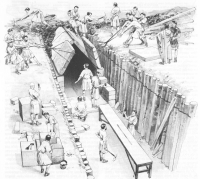
5. Construction and Materials
Who and how were Roman aqueducts built?Here a set of questions with relevant answers, some of which are linked to related subjects as discussed in other places within this website www.romanaqueducts.info
Additional questions or remarks are most welcome via w.d.schram 'at' romanaqueducts.info
Questions
- How were Roman aqueducts built?
- How were Roman aqueducts made?
- Who built the aqueducts?
- Why did the Romans use limestone?
- What were the aqueducts made out of?
- How big were the channels, bridges and tunnels of the aqueducts?
- What are the arches on a Roman aqueduct used for?
Note the stone workers left and the long 'table' which was a measuring instrument called chorobates.
Answer
After the design phase where the main decisions were already made (trace, bridges, tunnels etc), the actual construction phase took place, starting with foundations etc. There are quite a few examples of known mistakes of aqueduct constructions like abandoned traces and twin bridges (because of ground instabilities a second bridge was built parallel to the original one, see Frejus). Most famous is the story of the army engineer Nonius Datus and the aqueduct tunnel near Saldae (Tunisia) were two working crews - without Datus' supervision - had started on both sides of a mountain and did not meet in the middle.Whenever possible a 'cut-and-cover'-technique was applied, and sometime a qanat-like system was necessary. This was a system were vertical shafts were dug at regular intervals and connected to each other horizontally. Most work was done by slaves, some of which were well trained and experienced men. Mainly in the East of the Empire terracotta pipes were used. The most frequently applied material was stone (bricks for masonry, cuts in rocks, rock-cut pipes), like limestone. When ever possible building materials were quarried nearby. Lead pipes were used for water distribution within the towns and sometimes applied in so-called siphons. More exotic is the use of wood (pipes made of bored trees, a gutter made of boards); even leather channels have been known.
An ancient Roman architect with the name of Vitruvius wrote a book De Architectura with a interesting chapter on aqueduct construction.